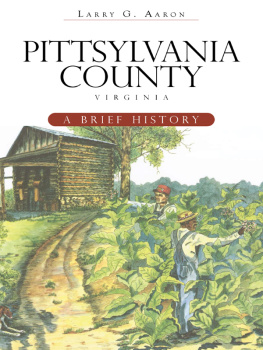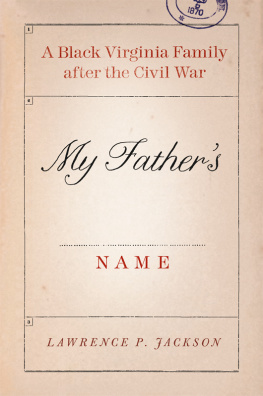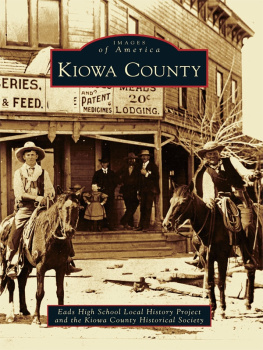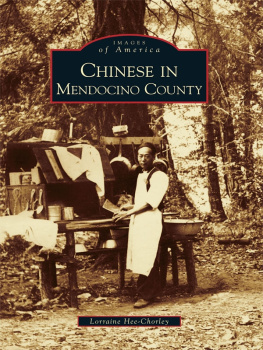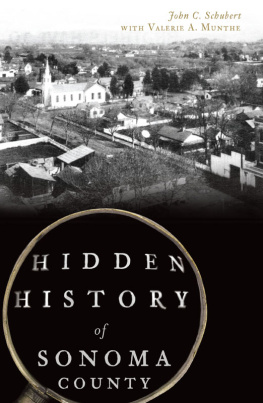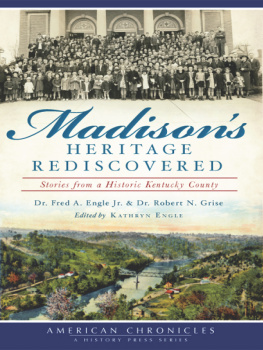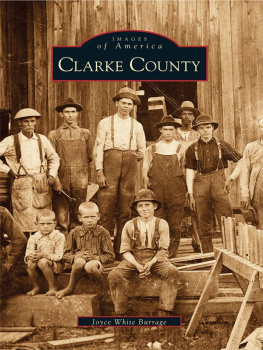
Published by The History Press
Charleston, SC 29403
www.historypress.net
Copyright 2009 by Larry G. Aaron
All rights reserved
First published 2009
e-book edition 2013
Manufactured in the United States
ISBN 978.1.62584.313.5
Library of Congress Cataloging-in-Publication Data
Aaron, Larry G.
Pittsylvania County, Virginia : a brief history / Larry G. Aaron.
p. cm.
Includes bibliographical references.
print edition ISBN 978-1-59629-531-5
1. Pittsylvania County (Va.)--History. I. Title.
F232.P7A226 2009
975.5665--dc22
2009000428
Notice: The information in this book is true and complete to the best of our knowledge. It is offered without guarantee on the part of the author or The History Press. The author and The History Press disclaim all liability in connection with the use of this book.
All rights reserved. No part of this book may be reproduced or transmitted in any form whatsoever without prior written permission from the publisher except in the case of brief quotations embodied in critical articles and reviews.
For my twin sisters
Bonnie and Connie
CONTENTS
ACKNOWLEDGEMENTS
In writing this brief history of Pittsylvania County, I have stood on the shoulders of others past and present. Their work is vastly more complete and detailed than this small volume in which I have attempted to present an overview of the people, places and events that have figured significantly in Pittsylvania County history.
The research of Maud Clement elegantly presented in The History of Pittsylvania County and published in 1929 is one of the best county histories available anywhere. The extensive published research of local historians Frances Hallam Hurt; Herman Melton; Henry and Patricia Mitchell and their daughter Sarah; Judge Langhorne Jones; Lawrence McFall; Danny Rickets; Roger and Anna Dodson; and others have been generously woven into this narrative.
Helpful publications included The Pittsylvania Packet, published quarterly by the Pittsylvania County Historical Society; the county newspaper the Star-Tribune; the bulletin of the Virginia/North Carolina Piedmont Genealogical Society, Piedmont Lineages, edited by Mike Williams; the Danville Register and Bee; and the graduate work of Karl Bridges and Caleb Brumfield.
Additional assistance with contributions came from Carol Motley, Pittsylvania Countys Economic Development director; William Gosnell, an authority on Pittsylvania County Native Americans; Deborah Morehead, director of communications and public relations for the Institute for Advanced Learning and Research; Terry Whitt, GIS coordinator for Pittsylvania County; Stephen Barts and Jamie Stowe, Pittsylvania County extension agents; Susan Worley of the Star-Tribune; Gayle Beverley Austin with the VaGen Web Pittsylvania County, Virginia Genealogy Project; the Reverend R.G. Rowland, pastor of Greenfield Baptist Church; Peggy Hudson; Steve and Sarah Welch; Pam Rietsch of CFC Productions; Davis Newman, chairman of the Veterans Memorial Committee; Chris Anderson, manager of BB&T bank in Chatham; and Claudia Emerson, Virginias poet laureate and Pulitzer Prize recipient.
Photographic contributions in addition to the author came from photographer Richard Davis, Pittsylvania County Archivist Desmond Kendrick, Lawrence McFall of Danville, Dr. William Black of Chatham Hall, the Star-Tribune archives, Mitchells Publications of Chatham, the City of Danvilles Multimedia Design Manager Mark Aron, the Library of Congress archives and Nancy Compton for her cover art.
Help with research also came from librarians at both the Pittsylvania and Danville public libraries, and clerk of courts records in Chatham. Assistance in reviewing the manuscript came from Bonnie Dawson; Henry Walker; Stephen Barts; Leon Compton; Gary Grant; Henry Mitchell; Laurie Moran, president of the Danville Pittsylvania County Chamber of Commerce; Lawrence McFall; Deborah Morehead; R.G. Rowland; Mary Catherine Plaster; and Kenyon Scott, president of the Pittsylvania County Historical Society.
The staff at The History Press is due a heartfelt thanks, including Project Editor Ryan Finn and especially Senior Commissioning Editor Laura All, without whose patience and encouragement this work would not have been completed.
Finally, I wish to thank my wife, Nancy, for her devotion to me as I spent long hours in research and at the keyboard composing the manuscript.
INTRODUCTION
Out of Virginias ninety-five counties, Pittsylvania County is the largest. Its geographical dimensions, including the independent city of Danville, amount to 1,027 square miles, making the county only 2 percent smaller than the state of Rhode Island. But there the similarities stop. According to the U.S. Census of 2000, Pittsylvania Countys population was 61,783, while Rhode Island was heavily populated, with just over a million people. The population density in Pittsylvania is 65 people per square mile; by contrast Rhode Island has over 1,000 for each square mile.
Pittsylvania County is larger than the District of Columbia and seventeen of the worlds smallest countries, including Vatican City, Monaco, San Marino, Liechtenstein and several independent island groups. It has a greater population density than Australia, Mongolia and Canada.
As a rural county, Pittsylvania is spacious and accommodating, with farms comprising 45 percent of its land area. Wide-open spaces still exist as they did during colonial days, and next-door neighbors are not necessarily right next door. It is a land of surprising beauty as well. Maud Clement, the countys premier historian, wrote that the early explorers saw the great rolling hills which lost themselves in the blue distance, the murmuring waters of crystal clear streams, and the broad sweeps of rich meadowlands. It is still much like that today, a rural wonderland.
Pittsylvania County is situated along the South Central Piedmont Plateau, with elevations normally between 400 and 800 feet on rolling to hilly land. The Smith Mountain range crosses the northwest corner, where the countys highest elevation reaches 2,043 feet. The White Oak Mountain range crosses mid-county and continues northeast.
The Dan River meanders along its southern border; the Banister River divides the county into northern and southern segments. The Staunton (Roanoke) River forms the countys northern border. The countys other rivers are the Sandy River, Pigg River and Stinking River. The county has eighty-two named creeks plus branches, forks and unnamed streams. The total mileage of all these waterways is over 1,600 miles. Laid end to end, they would stretch from Virginias Atlantic Coast to the middle of Colorado.
Pittsylvania County is surrounded by seven other counties: Bedford, Campbell, Halifax, Franklin and Henry in Virginia, and Caswell and Rockingham Counties in North Carolina. Danville, which began as a Pittsylvania County village of twenty-five acres, now comprises forty-four square miles. The community was part of the county for most of its existence, from 1783 until it received its charter as an independent city.
Pittsylvania has three incorporated townsHurt, Gretna and Chatham, the county seat. There are many smaller communities with names that have obvious local references, though some are not so obvious. Tightsqueeze, along todays Route 703 a short distance below Chatham, got its name from the difficulty wagons and buggies had in negotiating a narrow space between a blacksmith shop and a store, both built to the edge of the road. Renan got its name from someones admiration of French philosopher Ernest Renan. Kentuck was named by a traveler headed for Kentucky who stopped in the area for the night and never left. Ringgold nearby supposedly offered good prospects for gold mining, but hardly enough was ever found to even make a ring.
Next page
